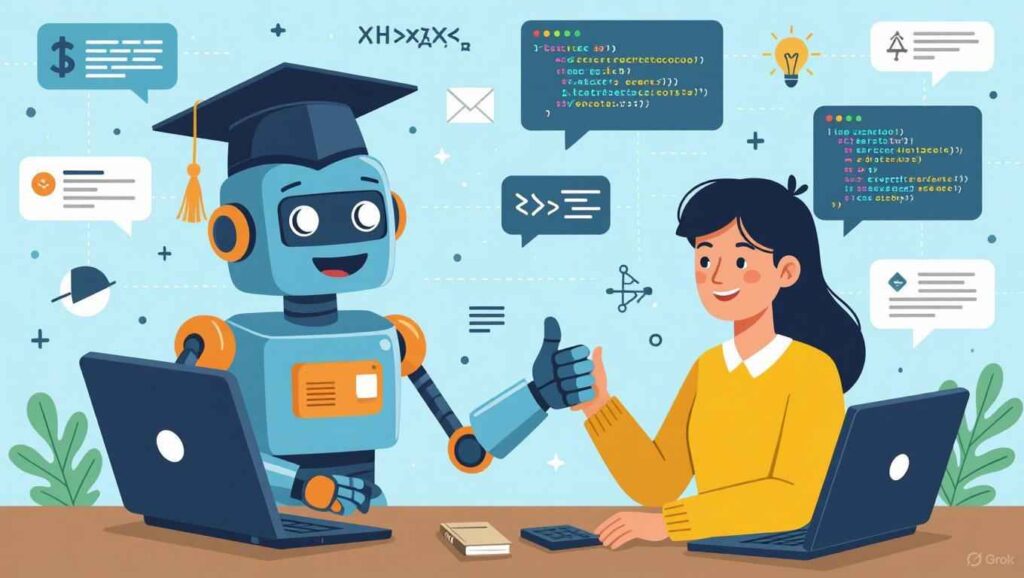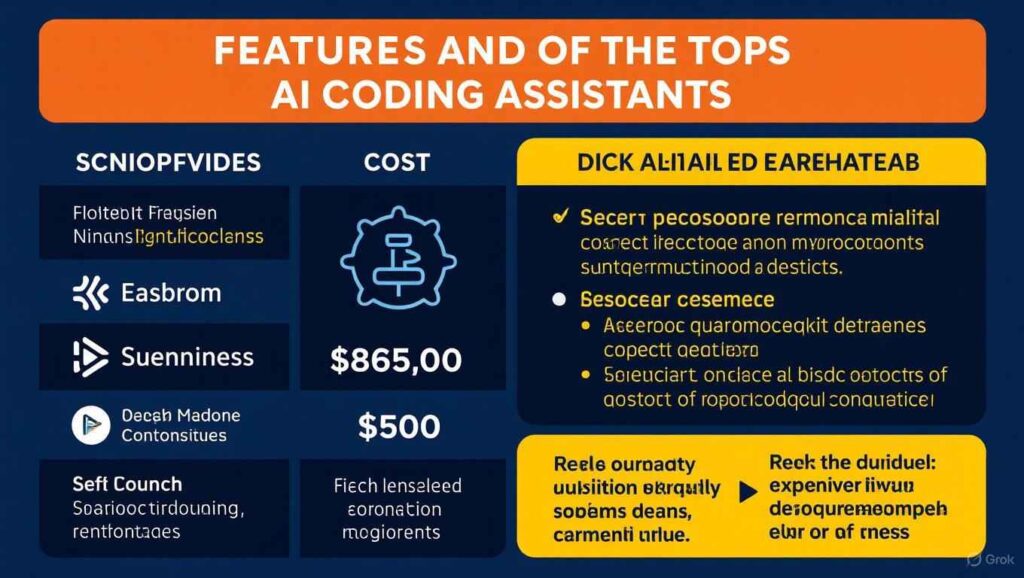Every computer science student knows the feeling: you’re staring at a blank screen, a cryptic error message, or a complex algorithm that just won’t click. The pressure of deadlines and the sheer volume of new information can be overwhelming. But what if you had a 24/7 personal tutor, debugging expert, and brainstorming partner right in your IDE? Enter the world of the AI coding assistant for students—a powerful ally designed to transform the way you learn, code, and complete your assignments.
In this comprehensive guide, we’ll dive deep into the world of AI coding tools, breaking down exactly what they are and how they can supercharge your academic journey. We’ll explore the top contenders, from industry giants to hidden gems, and show you how to pick the perfect best AI coding assistant for students to match your unique learning style and needs. By the end, you’ll be equipped with the knowledge to not just use these tools, but to master them, ensuring you don’t just pass your classes—you excel at them.
The AI Revolution: Why Every CS Student Needs an AI Coding Assistant
The days of relying solely on Stack Overflow and endless documentation are behind us. Modern computer science is a fast-paced field, and staying competitive means embracing the tools that make you more efficient and knowledgeable. An AI coding assistant is no longer a luxury; it’s a fundamental part of the modern developer’s toolkit. These tools, powered by advanced large language models (LLMs), have been trained on millions of lines of code to understand context, predict patterns, and generate new code.
For students, this translates into several key benefits:
- Accelerated Learning: Get real-time explanations for complex concepts and code snippets.
- Improved Productivity: Automate repetitive tasks like writing boilerplate code, documentation, and unit tests.
- Enhanced Code Quality: Receive suggestions for cleaner, more efficient, and more secure code.
- Debugging on Demand: Quickly pinpoint and fix errors, allowing you to spend less time debugging and more time learning.
In short, using an AI coding tool for students is like having a seasoned pair programmer by your side, ready to offer guidance and support exactly when you need it. This not only helps you complete your work faster but also deepens your understanding of core programming principles.
The Top Contenders: A Detailed Look at the Best AI Coding Assistant for Students
Choosing the right tool is critical, as each assistant has its own strengths. We’ve handpicked and evaluated the top options on the market, focusing on features, pricing, and suitability for computer science students.
1. GitHub Copilot: The Industry Standard for Code Completion
GitHub Copilot is arguably the most well-known and widely used AI coding tool. Developed by GitHub in partnership with OpenAI, it seamlessly integrates with popular IDEs like VS Code, JetBrains, and Neovim.
Why it’s great for students:
- Superior Code Suggestions: Trained on an enormous dataset of public code, Copilot’s suggestions are often highly accurate and context-aware.
- Copilot Chat: The interactive chat feature allows you to ask questions, explain code, and brainstorm ideas in natural language. It’s a fantastic way to learn by doing.
- Free for Students: GitHub offers Copilot for free to verified students, teachers, and open-source maintainers, making it an accessible and powerful choice.
Potential Downsides:
- Some students may become overly reliant on its suggestions, potentially hindering their ability to problem-solve independently.
2. Tabnine: Privacy-Focused and Highly Customizable
Tabnine is a strong alternative that stands out for its emphasis on privacy. It offers both cloud-based and local AI models, giving users more control over their data.
Why it’s great for students:
- Focus on Privacy: If you’re working on a proprietary class project, Tabnine’s local models ensure your code never leaves your machine.
- Personalized Learning: The tool learns from your individual coding patterns and provides suggestions that align with your style.
- Broad Language Support: Tabnine supports over 30 programming languages, making it versatile for a range of courses.
Potential Downsides:
- The free version is more limited compared to its paid counterparts.
3. Google Gemini Code Assist: The New Challenger with an Edge
Google’s entry into the space, Gemini Code Assist, is powered by its cutting-edge Gemini LLM. It’s tightly integrated with Google Cloud services and is rapidly gaining traction.
Why it’s great for students:
- Contextual Understanding: Its large context window (up to 1 million tokens) means it understands your entire project, leading to more relevant and holistic suggestions.
- Citation of Sources: A unique feature that provides citations for the code it suggests, which can be invaluable for learning best practices and avoiding plagiarism. For more on this topic, check out our guide on The Ultimate Guide to Free AI Tools for Paraphrasing and Avoiding Plagiarism.
- Free for Individuals: Google has made Gemini Code Assist free for individual developers, making it an excellent, no-cost option.
4. Amazon Q Developer: Enterprise-Grade Assistance
Formerly known as CodeWhisperer, Amazon Q Developer is AWS’s offering. It’s built for enterprise environments but offers a free tier for individual developers.
Why it’s great for students:
- Built-in Security Scans: It automatically scans for security vulnerabilities and suggests immediate patches, an excellent feature for learning secure coding practices.
- Project-Wide Scope: It can handle multi-file changes and is designed for larger projects, preparing you for professional development.
- Free Tier: The individual plan is free, providing a no-risk way to try out its advanced features.
5. OpenAI Codex (via Playground): For the Experimental Learner
Codex is the model behind GitHub Copilot, and while it’s not a standalone product for the average user, you can access its power through the OpenAI API and Playground.
Why it’s great for students:
- Unrestricted Creativity: Allows you to experiment with prompts and code generation in a raw format, perfect for understanding the underlying technology.
- Debugging & Explanation: You can paste in code and ask the model to debug it or explain its functionality in detail. If you are a student, you might find this helpful when using AI for other academic tasks. For more, see our post on How to Use ChatGPT to Write a Research Paper Outline.
Potential Downsides:
- Requires some technical knowledge to use the API effectively. It’s not a plug-and-play solution like the others.
6. CodiumAI: The Test-Driven Development Assistant
CodiumAI is a tool focused on helping developers write meaningful tests for their code. It generates unit tests, docstrings, and explains the purpose of the code.
Why it’s great for students:
- Learning to Test: It’s an invaluable tool for learning and practicing test-driven development (TDD), a critical skill in the industry.
- Explaining Your Own Code: Its ability to generate explanations helps you solidify your understanding of the code you’ve written.
Potential Downsides:
- Primarily focused on testing, not general code completion, so it works best as a companion tool.

7. Replit Ghostwriter: The All-in-One IDE and Assistant
Replit Ghostwriter is an AI assistant built directly into the Replit online IDE. If you do your coding in a browser, this is an excellent choice.
Why it’s great for students:
- Zero Setup: You can start coding and get AI assistance instantly without any installations.
- Integrated Environment: It combines a powerful IDE, a coding assistant, and collaboration features in one place.
- “Explain” and “Transform” Features: Ghostwriter can explain complex code snippets and transform code into different languages or styles.
Potential Downsides:
- Tied to the Replit ecosystem, which may not be ideal for students who prefer a local IDE.
8. Codeium: The Free and Fast Alternative
Codeium is a modern AI coding assistant known for its speed and extensive language support. The core product is completely free for individual users.
Why it’s great for students:
- Completely Free: No hidden costs or feature limitations for the individual plan.
- Broad IDE Support: It supports over 70 IDEs and languages, making it a flexible choice for courses ranging from AI-based tools like an AI Mind Map Generator to more complex data science tasks.
- Fast and Accurate: Its suggestions are highly responsive and helpful for writing code quickly.
Potential Downsides:
- It is a newer tool, so its user community and long-term support are still developing.
9. Microsoft Copilot for VS Code: The Free Version of the Premium
While GitHub Copilot is the premium product, Microsoft has released a more basic, but still very useful, Copilot directly into VS Code. This is available through the VS Code extension marketplace.
Why it’s great for students:
- Easy Access: It’s a native part of VS Code, one of the most popular IDEs for students, making it incredibly easy to install and use.
- Basic Assistance: Provides helpful suggestions and autocompletion for common coding tasks.
Potential Downsides:
- Less powerful than the full GitHub Copilot, with a smaller context window and fewer advanced features.
10. CodeGeex: The Multi-Language Powerhouse
CodeGeex is an open-source AI coding assistant from the Tsinghua University team. It is trained on a wide range of programming languages and is excellent for those working with less common languages.
Why it’s great for students:
- Open-Source: You can inspect and contribute to the model, which is an excellent learning experience in itself.
- Multi-lingual Support: Excels at handling multiple programming languages, including those less supported by other tools.
Potential Downsides:
- Requires more manual setup and may not have the same polished user experience as a commercial product.

How an AI Coding Assistant for Students Accelerates Your Learning
Beyond just completing assignments, the real value of an AI coding assistant lies in its ability to act as a pedagogical tool. Here’s a closer look at how these tools help you learn more effectively.
Demystifying Complex Code
Have you ever encountered a piece of code in a textbook or a lecture that you just couldn’t wrap your head around? An AI assistant can explain it in simple, natural language. By pasting the code snippet and asking, “Explain this code,” you get an instant breakdown of its function, logic, and potential pitfalls. This kind of real-time, personalized feedback is something a textbook or a professor’s office hours can’t always provide. For more on this, consider exploring our guide on AI to Summarize Research Papers Easily in 2025 or 9 Ultimate: AI Tool That Converts Lecture Audio To Notes Easily.
The Power of Automated Refactoring and Documentation
Writing clean, well-documented code is a critical skill. An AI assistant can automatically generate documentation for your functions and classes, and it can suggest ways to refactor your code to be more readable and efficient. This not only improves the quality of your projects but also instills good habits that will serve you throughout your career. Instead of just writing code that “works,” you learn to write code that is professional and maintainable. This skill is as important as learning to use an AI Essay Writer for College Students or mastering an AI Study Planner App.
Building Your Project with the Best AI Coding Assistant for Students
Imagine you need to build a simple web server for a class project. Instead of spending hours looking up the right libraries and syntax, you can simply prompt your assistant: “Write a basic Python web server using the Flask framework.” The assistant will generate the boilerplate code, complete with comments and explanations, allowing you to focus on the unique, challenging parts of your project. This approach lets you learn by building, rather than getting bogged down in syntax. This same principle applies to other subjects, such as using an AI Math Solver Apps or an AI Physics Homework Helper.

Overcoming Challenges: The Responsible Use of AI in Academia
While the benefits are immense, the use of AI in education isn’t without its challenges. The key is to use these tools responsibly.
The Risk of Over-Reliance
The most significant risk is becoming overly dependent on the tool. If you let the AI write all your code without understanding the underlying principles, you’re not learning. The goal is to use the assistant as a helper, not a crutch. Always review the code it generates, and if you don’t understand it, ask the AI to explain it or research the concepts independently. This is similar to how you would use an AI Flashcard Generators for Exam Preparation—as a tool to reinforce learning, not replace it.
Ethical Considerations and Academic Honesty
It’s crucial to understand your university’s policy on AI-assisted work. While most institutions permit the use of AI for learning and productivity, some may have strict rules against submitting AI-generated code as your own. Always be transparent about how you used the tool and ensure your work demonstrates your own understanding and critical thinking. This includes citing your sources properly, a task made easier with the right AI Citation Generators.

Picking the Perfect AI for Coding Homework: A Buyer’s Guide
With so many options, how do you choose the right one for you? Here are the key factors to consider.
1. Integration: Does it work with your favorite IDE?
Most students use a specific IDE like VS Code or JetBrains. Ensure the tool you choose has seamless integration so you can use it without disrupting your workflow.
2. Language Support:
Are you primarily a Python student? Or do you need support for Java, C++, and JavaScript for different classes? Look for an assistant that supports all the languages you’ll need. This is particularly important for specialized tasks like using an AI Chemistry Tool for Balancing Equations or an AI for Graphing Complex Functions.
3. Cost: Is there a free tier or student discount?
For most students, cost is a major factor. GitHub Copilot, Google Gemini Code Assist, and Amazon Q Developer all offer generous free plans for students, which makes them highly attractive options. You can also explore alternatives to paid tools, such as the Best Symbolab or Photomath Alternatives with AI.
4. Features: What specific help do you need?
- Code Completion: Do you just need help with suggestions and boilerplate?
- Chat Interface: Do you want a conversational partner to help you debug and brainstorm?
- Code Explanation: Is your primary goal to understand complex concepts?
- Security Scans: Are you learning about secure coding and need help identifying vulnerabilities?
By evaluating these factors, you can find a tool that not only fits your budget but also provides the specific kind of assistance that will help you most. Just like a Pomodoro Timer App helps you focus, the right AI assistant can help you optimize your coding time.
FAQ: Your Most Common Questions About AI Coding Tools Answered
Q1: Is using an AI coding assistant for students considered cheating?
A1: This depends entirely on your school’s academic honesty policy. Most universities view these tools as a form of educational aid, similar to using a calculator in a math class. However, you must ensure the work you submit is your own and demonstrates your personal understanding of the concepts. Always check with your professor or department.
Q2: What’s the difference between a general AI chatbot and a specialized AI coding tool?
A2: A general AI chatbot (like ChatGPT) is a fantastic tool, but a specialized best AI coding assistant for students is trained specifically on vast amounts of code. This means it has a deeper, more contextual understanding of programming languages, libraries, and frameworks. It can provide more accurate and relevant code suggestions, explanations, and debugging help right inside your coding environment.
Q3: How can I use a best AI coding assistant for students to learn more, not just get the answer?
A3: Treat the AI as a learning partner. When it provides a solution, ask it to explain the logic behind it. Ask “why” certain choices were made. Experiment by asking for alternative solutions or different approaches. This proactive engagement turns a simple tool into a powerful teaching assistant.
Q4: Which is the best AI code assistant for beginners?
A4: For beginners, a tool with a strong chat interface and excellent code explanation capabilities is key. GitHub Copilot and Google Gemini Code Assist are both excellent choices because their chat features allow for a conversational and guided learning experience.
Q5: Can these tools really help with coding homework?
A5: Yes, they can be a game-changer. They can help you get unstuck on a bug, understand a tricky algorithm, or even generate the basic structure of a program so you can focus on the core logic. This can significantly reduce the time you spend on assignments, allowing you to allocate that time to studying or other subjects.
Q6: Are there any free options that are still good?
A6: Absolutely. GitHub Copilot, Google Gemini Code Assist, and Amazon Q Developer all offer free plans for verified students. These are not stripped-down versions; they are incredibly powerful tools that provide a full range of features to support your academic work.
Q7: Will using an AI assistant make me a less skilled developer?
A7: On the contrary. When used correctly, an AI assistant can make you a better developer. By automating the mundane tasks, it frees up your cognitive energy to focus on high-level problem-solving, architectural design, and learning new concepts—the skills that truly separate a good developer from a great one.
Q8: What if the code the AI generates is wrong or buggy?
A8: It’s important to remember that AI is not infallible. The code it produces can sometimes be buggy, inefficient, or even incorrect. This is why human oversight is so critical. Always review, test, and debug the code the AI generates. This process is a valuable part of the learning experience and reinforces your own skills.
Conclusion: The Future of Learning with the Best AI Coding Assistant for Students
The integration of AI into computer science education is not a passing trend; it’s a fundamental shift in how we approach learning and problem-solving. By embracing tools like the best AI coding assistant for students, you are not just getting a shortcut to a finished assignment. You are acquiring a new superpower—the ability to learn faster, work smarter, and build more ambitious projects than ever before.
For the aspiring developer, the key is to use these tools not as a substitute for your own intellect, but as a powerful extension of it. Use them to debug, to explain, to brainstorm, and to accelerate your journey from novice to master. The future of coding is here, and with the right AI assistant by your side, you are perfectly positioned to seize it.